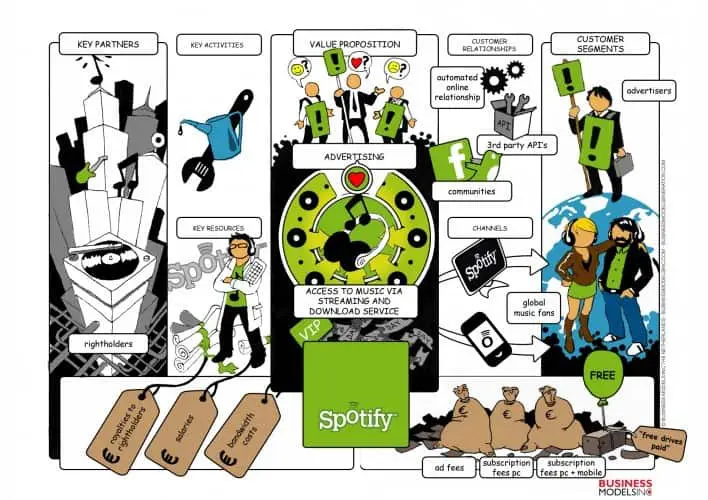How To Use A Business Model Canvas When Your User Isn’t Your Customer
Most of the time in the Youth Wellbeing space, the people using an intervention AREN’T the people who pay for the service.
Example: Young people going to a youth club often pay nothing to attend – the costs are covered by a community group or local council as they see the value in giving young people a space to spend time together.
Whether you’re running a for-profit business or a not-for-profit, planning an event, setting up a charity, or developing the next Fitbit – you’re going to need resources and a compelling proposition about why people would interact with your organisation.
Whatever it is, you need to acknowledge the revenue, donations, volunteer time and other sorts of resources that you will rely on to be impactful and sustainable. So don’t get lost in the ‘business model’ part – everyone can use these tools to model their projects.
However, this split of user and customer often causes confusion when we’re using great startup modelling tools like the Social Business Model Canvas or Lean Canvas; they don’t seem to have space for this complexity.
The good news is that one of the leading authors of the startup canvas movement, Ash Maurya, wrote a great article awhile back about how to handle these kind of scenarios, which he calls multi-sided models:
“Unlike a direct business model where your users become your customers, a multi-sided business model is a multi-actor model where your users and customers are distinct segments.” – Ash Maurya
Read Ash’s post Multi-sided Business Model post here
 Example of multi sided Business Model : Spotify – via http://bit.ly/1OJRDk4
Example of multi sided Business Model : Spotify – via http://bit.ly/1OJRDk4
So, how do we practically apply this thinking in a Youth Wellbeing context?
Here’s a blow-by-blow version of how we’d actually take this technique and bring it to life for a youth wellbeing project. Need an example? Use the ? button in the bottom right to chat with us.
1) Identify our assumptions about who we’re creating value for
Map out the people or organisations who have a vested interest in your space. You could use a mind map tool such as Kumu.io or just plain paper and pen.
2) Identify the likely or actual user
Who will actually be using the product / service / experience? For example, if you want to create a website with information about ‘Connecting for Wellbeing’, your users might be students at the end of high school about to head into the world of work.
3) Rank the other actors in order of who you create most value for
You may need to be creative in your thinking here; other common actors in the Youth space are:
Parents, Schools, Government, Health Promotion Agency, Churches, Businesses, Youth Groups etc
Next we need to be able to explain how we create value…
4) Write down your value proposition for your Users
We start with the value proposition for our user as they are generally much more risky – if you can’t deliver the service, experience or behaviour change for this group, then it is highly unlikely that your ‘customer’ will pay you for your work.
Great tool for this is the Value Proposition Design canvas which we’ve written about here.
5) Create a Social Lean Canvas for this user
Write in your value proposition that you outlined in detail in the value proposition canvas.
6) Write down your value proposition for your Primary Customer
Your primary customer is the one at the top of your ‘other actors’ list from step 3.
Use the Value Proposition Design canvas again.
6) Create another, separate Social Lean Canvas, for this Primary Customer
NOTE:
Yes, you need two separate canvases to model your project, as you are effectively working out entire different strategies for each of them.
You can merge them eventually if you like – using colours to identify what content relates to users, and what to customers – as suggested in Ash Maurya’s post.
Now we need to check whether our assumptions about our Value Propositions are true, and whether the people or organisations – our users and customers – will engage.
Now comes the hard part. It can take a long time to find “fit” between what we think is a great idea, and what people are willing to use and pay for. You need both to happen if you’re going to make sustainable impact over time.
7) Check your User value proposition
You now need to get out of your ivory tower, and put your ideas to the test. There is much more written about this in the Value Proposition Design book. We highly suggest getting a copy – it lays out a range of ways you can test your value propositions.
You can also see our resource about running experiments here.
8) Check your Customer value proposition
As above – finding a value proposition, at a price that a customer can afford, is a difficult and sometimes long path for new projects.
However, it’s the fundamental part of creating a sustainable organisation or social business…
“A project without a repeatable financial model is a hobby not an project which will create ongoing sustainable impact.”
There’s much more ahead of you beyond just proving something on paper, so why not check out some of our resources to help you navigate the path ahead? You can also come to one of our events, or check out our Fellowship programs.
We’d love to know how you get on with this process – drop us a note in the comments!
